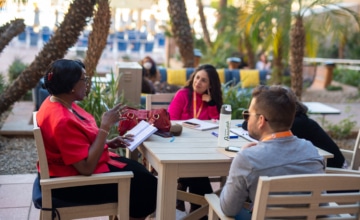by Iheoma U. Iruka, Chief Research Innovation Officer and Director, HighScope Educational Research Foundation and Wahyuni Ratna Lingga, Business Quality Manager, HighScope Indonesia Institute
By the time children enter kindergarten, they are expected to have mastered certain academic (e.g., reading and math) skills and to have achieved the social–emotional skills necessary for success in the school environment. These expectations, along with the evolving science of early childhood development, have led to a more thorough examination of and investment in the quality of early care and education (ECE) programs serving young children, not only in the United States, but across the globe. This growing recognition of the importance of the earliest years of life is evident in the United Nations Sustainable Development Goals (SDGs) that outline 17 global goals considered central to sustainable development in all countries. The goals recognize the importance of early childhood development and seek to ensure that children have access to inclusive and high-quality education throughout childhood.
The concept of quality in ECE is multidimensional. Quality dimensions include the provider–child relationship, activities and materials related to learning activities, the organization and management of care settings, and the family–educator relationship. The quality of ECE environments is often examined through structural and process features. Structural features include group size, ratio, population served (e.g., infant, special needs), teacher education and training (Cassidy et al., 2005). Process features include quality of instruction, age-appropriate materials, and the sensitivity of providers’ interactions with children (Cassidy et al., 2005; Mashburn et al., 2008). It is posited that structural features provide “the foundation for process indicators” (Cassidy et al., 2005, p. 507). Studies of dimensions of quality and their relationship to child outcomes (Cassidy et al., 2005) have found that higher quality interactions and teaching are more likely in programs with highly educated and trained teachers and providers, as they have the knowledge, ability, and skills to meet children’s cognitive, language, and social–emotional needs.
The HighScope Perry Preschool Study is a well-known longitudinal research project that has helped make a strong case for the relationship between participation in a high-quality ECE program and a broad range of positive outcomes in later childhood and adulthood (Heckman, Moon, Pinto, Savelyev, & Yavitz, 2010). The HighScope curriculum is based on the child development theories of Piaget, Vygotsky, and Dewey (Epstein & Hohmann, 2012) and identifies a comprehensive list of indicators of children’s development and learning. The curriculum is based on five principles:
- recognition of children as active learners who learn best from activities that they themselves plan, carry out, and reflect on;
- emphasis on the importance of supportive and nurturing adult–child interaction;
- learning environments arranged to support children’s active, interest-based learning;
- consistent daily routines following a “plan-do-review” sequence, in which children choose what they will do, carry out their ideas, and reflect on their activities with teachers and peers; and
- engagement in the regular assessment of children.
These HighScope principles and curriculum are being used across the globe, particularly within the HighScope International Institutes located in Canada, Chile, China, Indonesia, Ireland, Mexico, Netherlands, Portugal, South Africa, and South Korea. In addition to supporting active participatory learning, the goals of these international institutes are to:
- advance learning environments through HighScope principles;
- maximize the potential of all children and youth regardless of their national, economic, ethnic, racial, religious, or other origins; and
- promote global understanding and cooperation with members of the HighScope International Registry.
A systematic evaluation of the HighScope International Institutes is currently being undertaken. In the meantime, however, we can share some anecdotal evidence about the positive impacts of the HighScope approach from our Indonesia site.
HighScope Indonesia was established in 1996 in Pondok Indah, a housing complex. Due to its rapid growth, the school was relocated to Cilandak, South Jakarta in 2002. In 21 years, HighScope Indonesia has grown to 11 schools which consists of early childhood education, elementary, middle, and high schools. The early childhood education program is divided into two classes: Early Preschool (18 – 36 months) and Preschool Program (2.5 – 6 years old).
While HighScope Indonesia leaders underscore that many of the HighScope principles are key to the improved child outcomes, they stress the most critical factor that matters is adult–child interactions. They note that responsive adult–child interactions in the context of daily routines supported children’s initiative and problem solving. Some parents have told teachers that their children are more independent, which is valued in some segments of Indonesian culture. For example, one parent shares that her daughter “tries to put on her own shoes and t-shirt, and eats her meals on her own.” These adult–child interactions also support children’s language development when teachers frequently communicate and rephrase children’s gestures and intentions. One parent stated that her child “uses a greater number of words now. When she first enrolled, her vocabulary was limited, especially in English. But, in only 9 months, she is now able to say a full phrase in English.” Improved child social skills, especially in their willingness to initiate interactions and play with other children has also been attributed to the high-quality, nurturing adult–child interactions.
While elevating the value of children’s early years for parents, communities, and policymakers remains a challenge across the globe, HighScope seeks to leverage its International affiliate by highlighting evidence from the sites of the long-term impact of nurturing and enriching early childhood educators. This will help meet the U.N. Sustainable Development Goals focused on strengthening the schooling and lives of children and youth.
References
Cassidy, D. J., Hestenes, L. L., Hansen, J. K., Hegde, A., Shim, J., & Hestenes, S. (2005). Revisiting the two faces of child care quality: Structure and process. Early Education & Development, 16(4), 505–520. doi: 10.1207/s15566935eed1604_10
Epstein, A. S., & Hohmann, M. (2012). The HighScope preschool curriculum. Ypsilanti, MI: HighScope Press.
Heckman, J. J., Moon, S. H., Pinto, R., Savelyev, P. A., & Yavitz, A. (2010). The rate of return to the HighScope Perry Preschool Program. Journal of Public Economics, 94(1), 114–128. doi: 10.1016/j.jpubeco.2009.11.001
Mashburn, A. J., Pianta, R. C., Hamre, B. K., Downer, J. T., Barbarin, O. A., Bryant, D., … Howes, C. (2008). Measures of classroom quality in prekindergarten and children’s development of academic, language, and social skills. Child Development, 79(3), 732–749. doi: 10.1111/j.1467-8624.2008.01154.x




